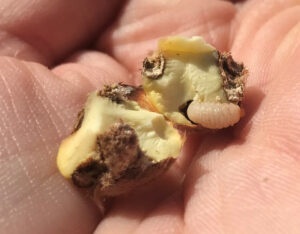
Aug 2, 2023Michigan chestnut crop report for the week of July 27, 2023
Michigan State University issued its chestnut crop report for the week of July 27. Erin Lizotte and Rob Sirrine from Michigan State University Extension provided the update.
Burs are developing and scouting for chestnut weevil should be underway.
Weather
The report indicates temperatures over the last 30 days were near average across the state. The east central and southeast Lower Peninsula received above average precipitation while north and western Michigan was below average. Drought conditions persist across much of Michigan, although recent precipitation should help alleviate dry conditions, according to the report.

Insects
Growers should be scouting for chestnut weevil as kernels develop. The lesser chestnut weevil (Curculio sayi) is an important pest of chestnut in Michigan. Lesser chestnut weevil is native to North America and host-specific, only infesting tree species in the genus Castanea (American chestnut, Chinese chestnut, European chestnut and chinquapin). Lesser chestnut weevil lay eggs on developing kernels and the resulting larvae feed on and damage the kernel making them unmarketable. Even worse, larvae present in nuts at harvest can result in “wormy” nuts making their way to consumers. Over the last decade, Michigan chestnut producers have observed an overall increase in the number of lesser chestnut weevil larvae in nuts at harvest, particularly in southern Michigan. The highest lesser chestnut weevil infestation levels are observed in years with lower yields.
Lesser chestnut weevil have robust bodies, long snouts and are dark brown or tan with brown mottling or stripes. Lesser chestnut weevils are 0.25 inch in length, with a snout of equal or greater length. In Michigan, a small number of adult lesser chestnut weevil begin to emerge in June-July as catkins form, but based on trapping data, most of the adult activity occurs in September and October as burrs develop and mature. During September and October, adult weevils mate in the chestnut canopy and females then lay eggs in the kernels. Eggs hatch in one to two weeks and the larvae begin feeding inside the kernels. The larvae feed inside the kernel for three to five weeks before exiting the nuts, dropping to the orchard floor and burrowing into the soil. The larvae remain in the soil for one to three years before pupating and emerging as adults, according to the report.
“Scouting for adult weevils should begin just before catkin bloom and continue regularly until harvest using visual observation and limb-tapping. To use the limb-tapping technique, place a light-colored sheet under the limb you are sampling and tap the branch with a padded pole or stick (gently to avoid damage to the tree). Jarring the branch causes the weevils to drop from the tree onto the sheet. Weevils will “play dead” when disturbed, so don’t be fooled. Chestnut weevils are substantial in size and should be visible if present. Be sure to limb-tap tree on both the edges and interior of orchards as well as any known hotspots,” the report stated.
Read more of the report here.







